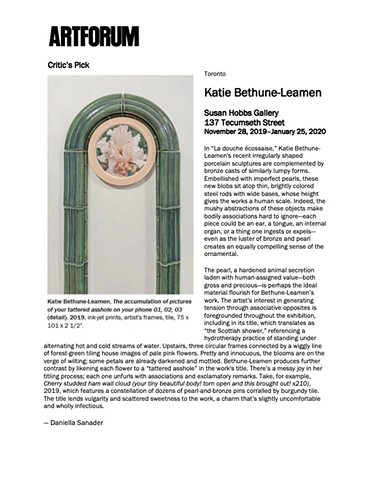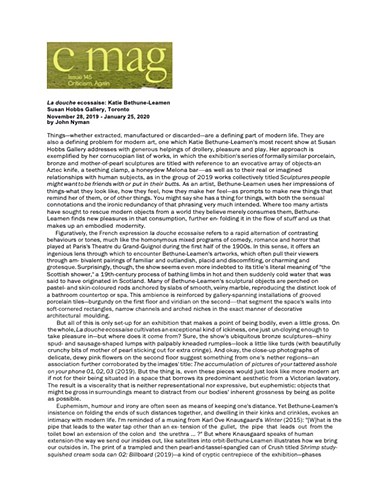D. Sanader, Artforum "Critic's Pick" Jan. 2020
J. Nyman, C Magazine, "La Douche Ecossaise: Katie Bethune-Leamen", Issue 145, 2020
Complete text:
La douche ecossaise: Katie Bethune-Leamen Susan Hobbs Gallery, Toronto
November 28, 2019 - January 25, 2020 by John Nyman
Things—whether extracted, manufactured or discarded—are a defining part of modern life. They are also a defining problem for modern art, one which Katie Bethune-Leamen's most recent show at Susan Hobbs Gallery addresses with generous helpings of drollery, pleasure and play. Her approach is exemplified by her cornucopian list of works, in which the exhibition's series of formally similar porcelain, bronze and mother-of-pearl sculptures are titled with reference to an evocative array of objects-an Aztec knife, a teething clamp, a honeydew Melona bar—as well as to their real or imagined relationships with human subjects, as in the group of 2019 works collectively titled Sculptures people might want to be friends with or put in their butts. As an artist, Bethune-Leamen uses her impressions of things-what they look like, how they feel, how they make her feel—as prompts to make new things that remind her of them, or of other things. You might say she has a thing for things, with both the sensual connotations and the ironic redundancy of that phrasing very much intended. Where too many artists have sought to rescue modern objects from a world they believe merely consumes them, Bethune- Leamen finds new pleasures in that consumption, further en- folding it in the flow of stuff and us that makes up an embodied modernity.
Figuratively, the French expression la douche ecossaise refers to a rapid alternation of contrasting behaviours or tones, much like the homonymous mixed programs of comedy, romance and horror that played at Paris's Theatre du Grand-Guignol during the first half of the 1900s. In this sense, it offers an ingenious lens through which to encounter Bethune-Leamen's artworks, which often pull their viewers through am- bivalent pairings of familiar and outlandish, placid and discomfiting, or charming and grotesque. Surprisingly, though, the show seems even more indebted to its title's literal meaning of "the Scottish shower," a 19th-century process of bathing limbs in hot and then suddenly cold water that was said to have originated in Scotland. Many of Bethune-Leamen's sculptural objects are perched on pastel- and skin-coloured rods anchored by slabs of smooth, veiny marble, reproducing the distinct look of a bathroom countertop or spa. This ambience is reinforced by gallery-spanning installations of grooved porcelain tiles—burgundy on the first floor and viridian on the second—that segment the space's walls into soft-cornered rectangles, narrow channels and arched niches in the exact manner of decorative architectural moulding.
But all of this is only set-up for an exhibition that makes a point of being bodily, even a little gross. On the whole, La douche ecossaise cultivates an exceptional kind of ickiness, one just un-cloying enough to take pleasure in—but where does it come from? Sure, the show's ubiquitous bronze sculptures—shiny spud- and sausage-shaped lumps with palpably kneaded rumples—look a little like turds (with beautifully crunchy bits of mother of pearl sticking out for extra cringe). And okay, the close-up photographs of delicate, dewy pink flowers on the second floor suggest something from one's nether regions—an association further corroborated by the images' title: The accumulation of pictures of your tattered asshole on your phone 01, 02, 03 (2019). But the thing is, even these pieces would just look like more modern art if not for their being situated in a space that borrows its predominant aesthetic from a Victorian lavatory. The result is a viscerality that is neither representational nor expressive, but euphemistic: objects that might be gross in surroundings meant to distract from our bodies' inherent grossness by being as polite as possible.
Euphemism, humour and irony are often seen as means of keeping one's distance. Yet Bethune-Leamen's insistence on folding the ends of such distances together, and dwelling in their kinks and crinkles, evokes an intimacy with modern life. I'm reminded of a musing from Karl Ove Knausgaard's Winter (2015): "[W]hat is the pipe that leads to the water tap other than an ex- tension of the gullet, the pipe that leads out from the toilet bowl an extension of the colon and the urethra ... ?" But where Knausgaard speaks of human extension-the way we send our insides out, like satellites into orbit-Bethune-Leamen illustrates how we bring our outsides in. The print of a trampled and then pearl-and-tassel-spangled can of Crush titled Shrimp study- squished cream soda can 02: Billboard (2019)—a kind of cryptic centrepiece of the exhibition—phases between imagination and trash. Even the grid-folded Paper it rests on evokes both cheap advertising material and a plush, quilted mattress. In bizarrely analogous fashion, the face-like, partially pearl-studded wads of white clay pictured in Pearl blob face I Green Man 01 (no pearls) x mascarpone, 02 (2 pearls) x gardenia and 03 (lotsa pearls) x frostine (all 2019) also push out and in, bubbling recognizable forms out of their bulbous masses while simultaneously absorbing us in the false interiority of the face.
Just below the surface, almost everything in La douche ecossaise bears reference to water; like in Knausgaard's vision, it's water in the pipes behind the walls, water under the skin. The pearls invoke a direct connection to water, while the porcelain tiles dialogue with water by demarcating and enclosing its proper space. Water is in full bloom in the dewdrops of The accumulation of pictures..., but only behind thick, fleshy frames, which make it seem as if the flowers are being viewed through the portholes of a submarine. Much lip service is paid to the idea of sidestepping the linear (read: capitalistic, imperialistic, environ- mentally destructive) notion of progress implied by modernity's objects and aesthetics, but embodying its alternatives is both a more difficult and a subtler affair. In fact, easy contrasts between the modern technologies of hierarchization and a supposedly ancient feeling of oneness have been around since modernity's beginnings. For those more deeply concerned with the problem, Bethune-Leamen addresses it on a level that is not dismissive but integrative; her modernity is both spiritually embodied and viscerally dismembered, refreshingly novel and same old, same old at once.John Nyman is a poet, critic and scholar from Toronto.

